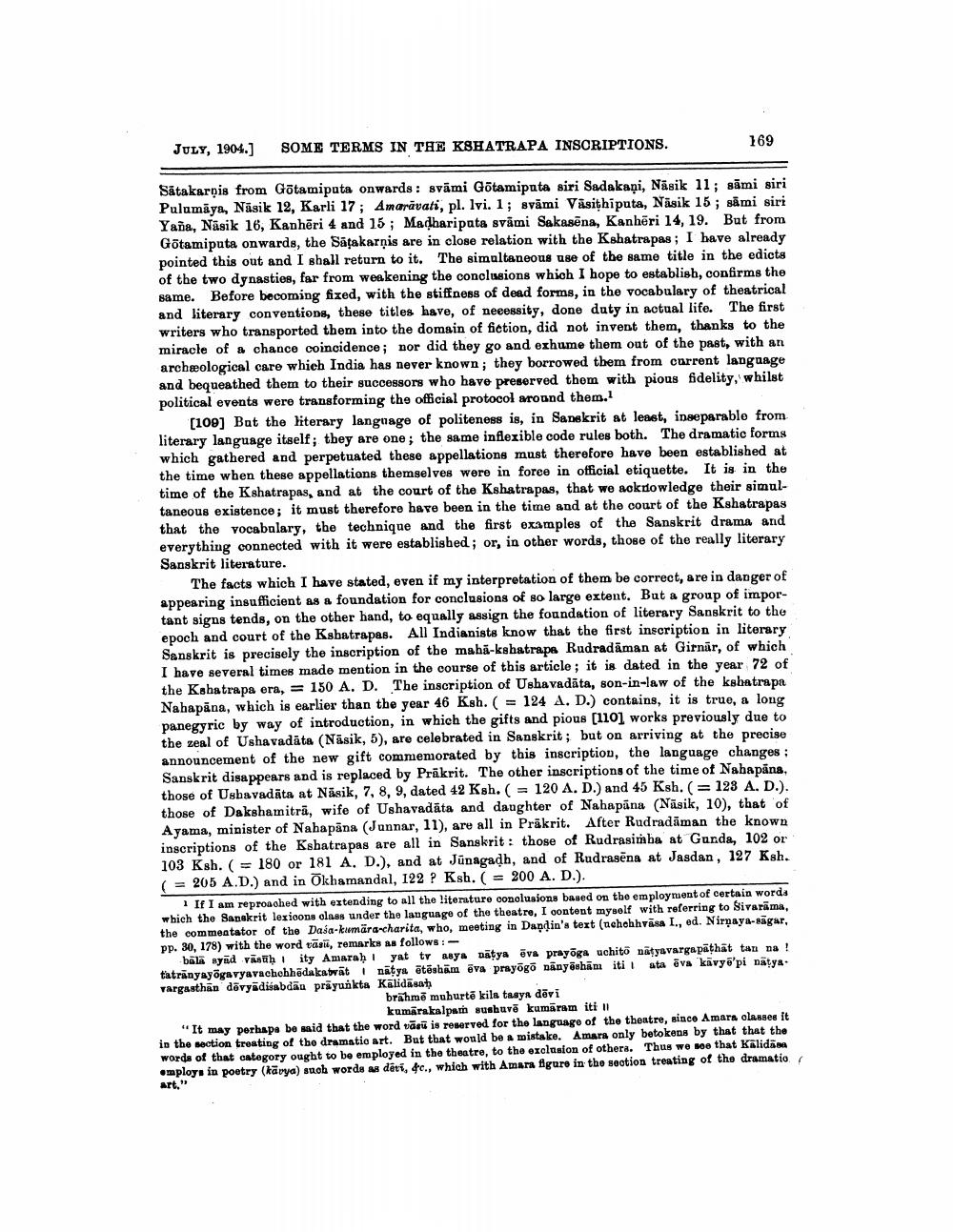________________
JULY, 1904.)
SOME TERMS IN THE KSHATRAPA INSCRIPTIONS.
169
Satakarpis from Götamiputa onwards: svāmi Götamiputa siri Sadakani, Nasik 11; sāmi siri Pulumāya, Nāsik 12, Karli 17; Amaravati, pl. lvi. 1; svämi Visithiputa, Näsik 15; sâmi siri Yana, Näsik 16, Kanhēri 4 and 15; Madhari pats svāmi Sakasēna, Kanhöri 14, 19. But from Götamiputa onwards, the Satakarnis are in close relation with the Kshatrapas; I have already pointed this out and I shall return to it. The simultaneous use of the same title in the edicts of the two dynasties, far from weakening the conclusions which I hope to establish, confirms the same. Before becoming fized, with the stiffness of dead forms, in the vocabulary of theatrical and literary conventions, these titles have, of necessity, done duty in actual life. The first writers who transported them into the domain of fiction, did not invent them, thanks to the miracle of a chance coincidence; nor did they go and exhumo them out of the past, with an archeological care which India has never known; they borrowed them from current language and bequeathed them to their successors who have preserved them with pious fidelity, whilst political events were transforming the official protocol around them.!
[109] But the literary language of politeness is, in Sanskrit at least, inseparable from literary language itself; they are one; the same inflexible code rules both. The dramatic forms which gathered and perpetuated these appellations must therefore have been established at the time when these appellations themselves were in force in official etiquette. It is in the time of the Kshatrapas, and at the court of the Kshatrapas, that we acknowledge their simultaneous existence; it must therefore have been in the time and at the court of the Kshatrapas that the vocabulary, the technique and the first examples of the Sanskrit drama and everything connected with it were established; or, in other words, those of the really literary Sanskrit literature.
The facts which I have stated, even if my interpretation of them be correct, are in danger of appearing insufficient as a foundation for conclusions of so large extent. But a group of important signs tends, on the other hand, to equally assign the foundation of literary Sanskrit to the epoch and court of the Kshatrapas. All Indianists know that the first inscription in literary Sanskrit is precisely the inscription of the mahă-kshatraps Rudradāman at Girnar, of which I have several times made mention in the course of this article ; it is dated in the year 72 of the Kshatrapa era, = 150 A. D. The inscription of Ushavadāta, son-in-law of the kshatrapa Nahapāna, which is earlier than the year 46 Ksh. ( = 124 A. D.) contains, it is true, a long panegyric by way of introduction, in which the gifts and pious [110] works previously due to the zeal of Ushavadāta (Nasik, 5), are celebrated in Sanskrit; but on arriving at the precise announcement of the new gift commemorated by this inscription, the language changes : Sanskrit disappears and is replaced by Prakrit. The other inscriptions of the time of Nahapāna, those of Usbavadāta at Näsik, 7, 8, 9, dated 42 Ksh. ( = 120 A. D.) and 45 Ksh. ( = 128 A. D.). those of Dakshamitra, wife of Ushavadāta and daughter of Nahapāna (Nüsik, 10), that of Ayama, minister of Nahapana (Jannar, 11), are all in Präkrit. After Rudradiman the known inscriptions of the Kshatrapas are all in Sanskrit: those of Rudrasimba at Gunda, 102 or 103 Ksh. ( = 180 or 181 A, D.), and at Junagadh, and of Rudrasēna at Jasdan, 127 Ksh. ( = 205 A.D.) and in Okhamandal, 122 ? Ksh. ( = 200 A. D.).
1 If I am reproached with extending to all the literaturo conolusions based on the employment of certain words which the Sanskrit lexicons olass under the language of the theatre, I content myself with referring to Sivarama, the commentator of the Dasa-kumara-charita, who, meeting in Dandin's text (nehehhvisa I., ed. Nirnaya-sägar, pp. 30, 178) with the word tāsü, remarks as follows:
bala ayüd vasth ity Amarah! yat tv aaya natya öva prayoga uchito nätyavargapāthat tan na! tatranyayoga vyavachchhidakatwät nätya ötösbam ēva prayogo Dänyönham iti ata ēva kavyo'pi natya. vargasthan dövyādisabdau priyunkta Kalidasat
brahmē muhurtē kila tasya dēvi
kumarakalpam sushuro kumaram iti II "It may perhapa bo wid that the word vāsū is reserved for the language of the theatre, since Amara classes it in the section treating of the dramatio art. But that would be a mistake. Amara only betokens by that that the words of that category ought to be employed in the theatre, to the exclusion of others. Thus we so that Kalidão employ, in poetry (kārya) such words dåti, dc., which with Amara figure in the section treating of the dramatio/
Art.




